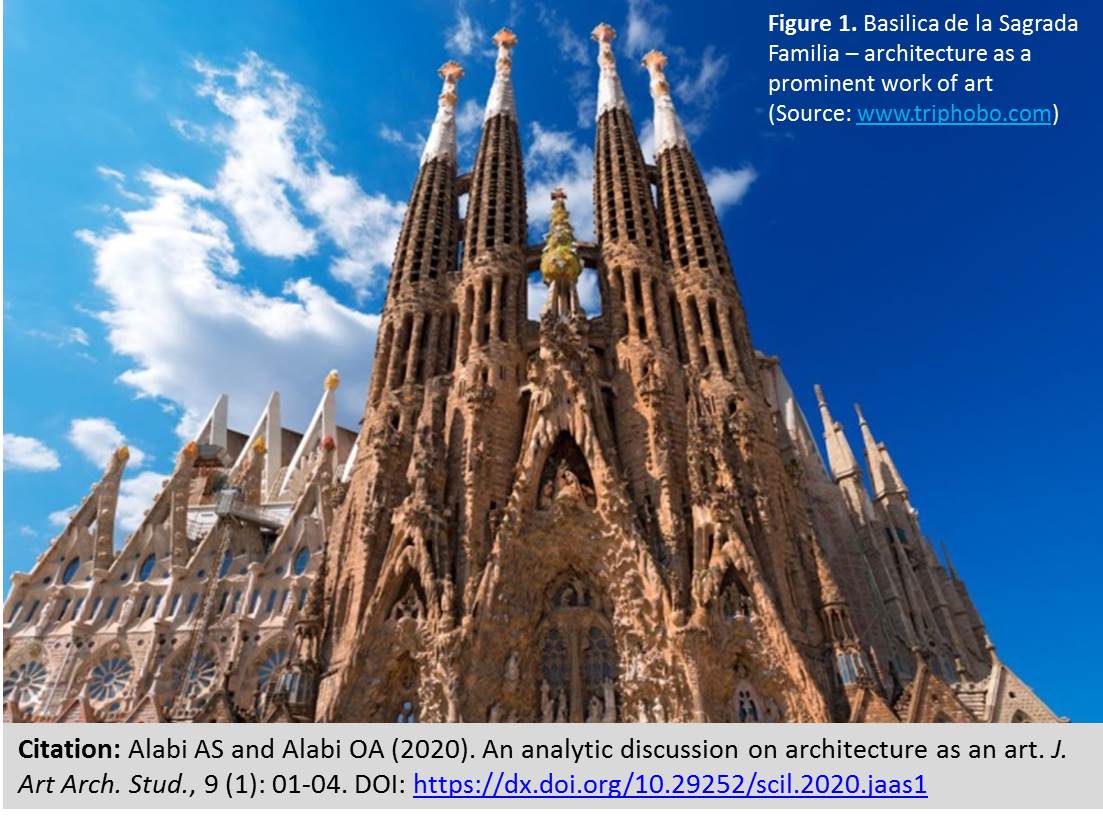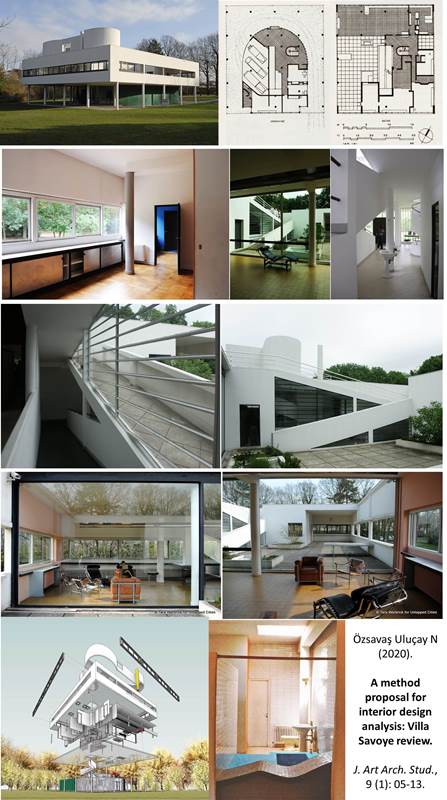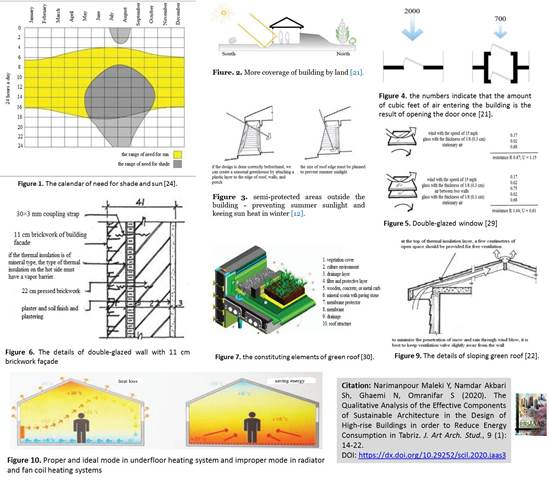Most read content
Previous issue | Next issue | Archive
![]() Volume 9 (1); June 15, 2020 [Booklet]
Volume 9 (1); June 15, 2020 [Booklet]
An analytic discussion on architecture as an art
Alabi AS and Alabi OA.
J. Art Arch. Stud., 9(1): 01-04, 2020; pii:S238315532000001-9
DOI: https://dx.doi.org/10.51148/jaas.2020.1
ABSTRACT
Architecture has been characterized to be a form of art by different scholars in the design field. Questions as to ‘whether architecture is always, sometimes of never an art form?’, and ‘if architecture is an art form, what makes it distinct from other art forms?’ have arisen. These questions are answered in this paper through metaphysical discussion underpinned by analytic philosophy of architecture. The argument put forward in this study provides a platform from which students of architecture and practicing architects can grasp the knowledge of the fundamental need for architecture to perform as an art and be much more than a mere aesthetic message. Thus, the study reveals architecture to be an art form which is distinct from other art forms because it goes beyond art to reveal itself as design which provides a particular functional requirement that shows responsibility for its existence.
Keywords: Architecture, Art, Buildings, Analytic Philosophy
[Full text-PDF] [HTML] [ePub] [XML] [Crossref Metadata] [Export from ePrints]
A method proposal for interior design analysis via Villa Savoye
Özsavaş Uluçay N.
J. Art Arch. Stud., 9(1): 05-13, 2020; pii:S238315532000002-9
DOI: https://dx.doi.org/10.51148/jaas.2020.2
ABSTRACT
The aim of this study is to examine the subject of modernism and the international style and to analyse a building of that period. The study provides a method for interior design analysis. In order to make interior analysis, a system consisting of basic design principles and architectural design criteria has been created. According to this method, space is evaluated in two parts as physical environment that includes architectural and interiors parts and aesthetic environment that includes elements of design and principles of design. In the study, interior design analysis of Villa Savoye designed by Le Corbusier is performed. Villa Savoye, which constitutes the basis of the design principles of the modern period and is one of the important examples in interior design, is analysed according to this method. As a result of this examination, Villa Savoye has been found to have the characteristics of the term appropriately but also has some application problems. With this study, it is aimed to contribute literature about interior design analysis method and adapt this method to a building.
Keywords: Interior Design Analysis, Method Proposal, Modernism, The International Style, Villa Savoye.
[Full text-PDF] [HTML] [ePub] [XML] [Crossref Metadata] [Export from ePrints]
The Qualitative Analysis of the Effective Components of Sustainable Architecture in the Design of High-rise Buildings in order to Reduce Energy Consumption in Tabriz
Narimanpour Maleki Y, Akbari Namdar Sh, Ghaemi N, Omranifar S.
J. Art Arch. Stud., 9(1): 14-22, 2020; pii:S238315532000003-9
DOI: https://dx.doi.org/10.51148/jaas.2020.3
ABSTRACT
The issue of energy in our country has not received considerable attention for years, however, in recent years, designers and planners sought to focus on the subject of the optimization of energy consumption in one of the major centers of energy consumption, that is building, due to the high cost of energy consumption and the concern about the depletion of these energy resources and the pollution arising from consuming these fuels. Meanwhile, tall buildings consume a large portion of non-renewable energy resources. Due to the construction of high-rise buildings, growing urban population, and limited proper land, designers should seek to reduce its negative environmental effects instead of rejecting it. Therefore, it is necessary to pay attention to sustainable architectural strategies in the process of designing and the exploitation stage of these buildings because of the accumulation of users at a limited level the significant use of energy resources in tall buildings. This paper attempts to analyze the effective elements in sustainable architecture in the design of high-rise buildings in Tabriz to reduce energy consumption. This study is of quantitative nature and data was collected using archive or library study. The findings of this research highlight that observing the effective components of sustainable architecture in the design of towering buildings contributes to saving energy consumption for space heating by 66%, and saving energy consumption for space cooling by 37.5 %.
Keywords: Sustainability, Climate, Energy Consumption, High-Rise Buildings
[Full text-PDF] [HTML] [ePub] [XML] [Crossref Metadata] [Export from ePrints]
Conceptual art in Turkey: Cengiz Çekil
Suyum FN and Zöngür C.
J. Art Arch. Stud., 9(1): 23-29, 2020; pii:S238315532000004-9
DOI: https://dx.doi.org/10.51148/jaas.2020.4
ABSTRACT
Conceptual Art emerged in the 1960s and displayed an entirely idiosyncratic structure as compared to those years’ prevailing form pursuits. It involved the art object in an intellectual process rather than a structural process. This very understanding, which keeps its distance from art object and prioritizes the artists’ ideas, enables the artists to express themselves by exploiting all kinds of materials. Similar tendencies became manifest in Turkey during the end of 1970s. Some Turkish artists returned back to the country after completing their studies abroad and with the occasion of biennials they became effective in the scene of conceptual art. Each of these artists produced individually important conceptual artworks, which represent their own time. This research is focused on Cengiz Çekil, who is an important representative of Conceptual Art in Turkey, the period when Conceptual Art emerged, its leading artists back then and their works. Furthermore, this paper includes the examination of Cengiz Çekil’s works which carry the social and cultural traces of his time, his interviews, art perception and both his position and importance in today’s Conceptual Art. Based on the existing examples the literature has been reviewed and the artist’s works have been analysed. When it comes to Conceptual Art in Turkey, one of the first names that come to mind is Cengiz Çekil. For, by means of the unique mentality he demonstrates through his ‘new’ and astonishing style, he has been one of the most prominent artists in Turkish art history.
Keywords: Cengiz Çekil, Conceptual Art, Sculpture, Installation.
[Full text-PDF] [HTML] [ePub] [XML] [Crossref Metadata] [Export from ePrints]
Previous issue | Next issue | Archive






